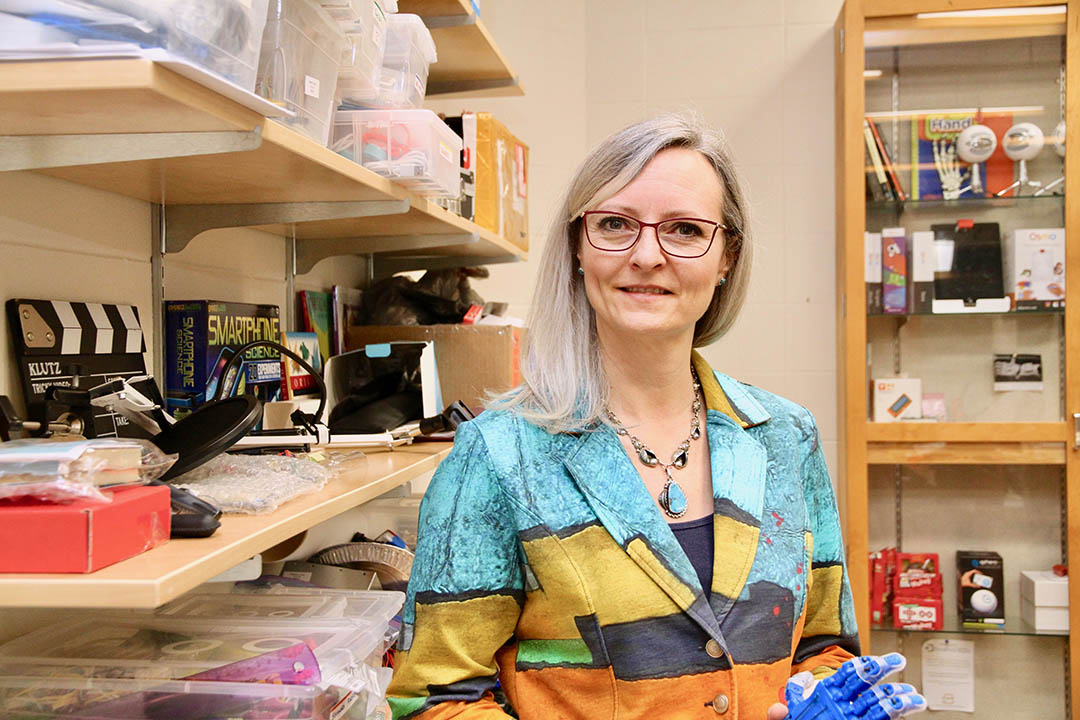
Spaghetti and 3-D printers
A small, clear acrylic cube whirs and hums on Marguerite Koole’s desk in her office on the third floor of the Education Building.
By Kris FosterThe 3-D printer, worth about $150, is adding thin lines of a bright green filament to what will eventually become an apparatus to organize cords for smartphones, computers, tablets and printers, and connect them to a power adaptor. This piece of green plastic is almost symbolic of Koole’s research that aims to connect technology with education in order to improve teaching and learning outcomes.
“Ultimately, what I am interested in is bringing together the study of teaching and learning with technology,” said Koole, who joined the Department of Curriculum Studies at the College of Education as an assistant professor in 2014. “I look at how technology can complement and support teaching and learning.”
Two areas of particular interest to Koole are mobile learning and makerspaces, both trendy topics that are backed by durable principles.
While pursuing her master’s in distance education at Athabasca University, Koole became interested in mobile learning and began looking at how mobile devices, such as smart phones and tablets, could be viable teaching tools no matter the location of the learner.
“In the early years of mobile learning, there was little theoretical work and even fewer models of mobile learning,” Koole said. “I realized there was possibility in these devices, which were a bit limited compared to the tools we have today.”
But as the flip phone became the smartphone, Koole began exploring the use of learning apps to support distance education, online learning and “learn where you live” curriculum.
“The next apps I want to start building are for Cree language learning. The apps would address ways of knowing that are linguistically and culturally appropriate,” she said.
A conceptually different, but equally diverse, learning tool that captured Koole’s attention is the makerspace. In its simplest form, she explained, it is a place where people come together to create, invent, learn, and share ideas, problems and solutions.
“There are so many different kinds of makerspaces that it is tough to define,” said Koole. “They cross so many boundaries. They can be physical or virtual. They can be high-tech and use 3-D printers, or low-end and use spaghetti for engineering projects.”
Unlike mobile learning, which is a relatively recent phenomenon, makerspaces have been around for centuries—it is only the name that is new.
“People have been working in groups for centuries,” said Koole. “We have been making and sharing things for hundreds of years. What’s different is that modern makerspaces reflect the entanglement of human, material and digital assemblages.”
Within those assemblages, Koole said makerspaces are a means of increasing student engagement and creativity in K-12 classrooms.
To that end, Koole has been running a type of living lab for the past couple years in an unmarked room in the basement of the Education Building. In her very own makerspace, filled with a variety of materials and tools, Koole and her group of makers, comprised of educational librarians and technologists, students, and teachers, get together to build stuff.
“This is my living lab, I watch people interact with technology and observe what might work in the classroom. I look at what people are doing, how it applies to kids and how teachers could do that in schools,” she said.
Koole said that learning in makerspaces is valuable because it helps “kids learn through real-world problem solving. It is space for active learning, it is creative and because of the way it can combine language, math, art and problem solving, it gives kids with a different way of understanding the world a way to shine.”
Koole said that while technology is a great tool to aid problem solving, sharpen the thinking process and to better understand failure, she is aware that the technology of makerspaces can be a deterrent for some teachers. That’s why she never “scares people with techy-talk” and focuses on the creative process rather than technology and materials. It is important to reduce the barriers to access.
“My goal is to get as many people interested in technology and realize it is not scary,” she said. “We don’t use technology for the sake of using technology, but rather to help learning.”
